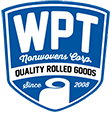
In the 1930s some companies began to do weird experiments with the waste (e.g., cotton) from manufacturing. By bonding some of these materials and then turning to fibers, these companies came up with what we now know as nonwoven fabrics. This is a humble beginning for what is now a multi-billion dollar industry.
Classified as disposable-or-non-durable (i.e., wipes, diapers, medical dressings, surgical gowns, etc.) or durable (carpets, automobile headliners, apparel interfacing, etc.), nonwovens generally subscribe to these contrasting characteristics:
- Resilient, soft feel or a hard, limited-pliability
- Very thin or very thick
- Opaque or translucent
- Made by heat bonding, gluing or simply by sewing
- High tensile strength or low-tearing strength
One area, though, where nonwoven fabrics shine is in the non-fraying department. As a general rule, nonwoven materials don’t fray—certainly not as easily as most woven or knit fabrics. This non-fraying property is one of the main reasons nonwovens are preferred over those easily-fraying counterparts.
Some Reasons Nonwoven Fabrics Don’t Fray
It’s the chemical nature of bonded fibers that give nonwoven its durable, non-fraying capacity. Because of this bonding, nonwovens boast of highly controllable & unique make, physical stability and high strength structures.
Just as knit fabrics don’t unravel—though stretching easily–nonwoven fabrics are tightly held together in a similar configuration, which dispels fraying.
Although some nonwovens may be pulled apart (if enough force is exerted), these fabrics won’t fray by virtue of the fact that its fibers are tightly held together by pressure, heat, resins and/or glue. This property is displayed even in such simple items as diapers or felt (the type use for crafts projects).
Another reason why nonwovens don’t fray is because of the different ways the material may be held together: chemicals, stitching or felting.
Woven fabrics, by contrast, fray easily, mainly because they are made by interlacing yarns using a loom. Nonwovens escape the “fraying curse” by not undergoing any such process.
Ironically, the fact that nonwoven fabrics aren’t held together in specific, must-do-or-die, secure ways is one of the reasons that, while they may be torn easily, they won’t fray.
Perhaps another peripheral reason nonwoven fabrics won’t fray is because they, especially the disposable type, may not be around long enough to be subjected to fraying.
It’s the very essence of the 3 main ways fibers in nonwoven fabrics are brought together that help provide those non-fraying properties. The 3 methods: chemical bonding (using glue-like compounds), mechanical bonding (“fiber entanglement”), and thermal bonding (melting fibers to each other). The structures formed provide for a rigidity and uniformity that makes fraying less likely.
Nonwoven fabrics end up as porous, flat sheets of material that were made directly from molten plastic/plastic film or from separate fibers. Because they aren’t knitted or weaved, nor require converting fibers into yarn, they don’t behave like or subscribe to the same vulnerabilities (e.g., fraying) as woven fabrics.
One of the biggest reasons nonwovens don’t fray is because this material is, after all, specifically manufactured to have whatever properties clients may desire or need. In the case of diapers, for example, a 2-layer approach provides a quick-absorbency rayon and a treated-polyester with eager fluid penetration. Having such control over this magnificent fabric means also being able to create a fabric that deters fraying. By the way, no such control over properties exists for most woven materials.
Yet another reason nonwoven fabrics don’t fray is because they are intentionally made to be in products that generally have to take lots of punishment or extensive usage. Consequently, nonwovens are found in furniture upholstery, draperies, towels, mattress padding, table cloths, carpet backing, blankets, caps, interlinings, linings, interfacings and reinforcements for certain fabrics.
Another reason nonwovens don’t fray is because the technology is heavily used for industrial purposes—which one might say is one of the most demanding. Accordingly, non-fraying nonwoven fabrics are used for insulation, filters, roadbed stabilization sheeting, packing materials, roofing products and geo-textiles.
Yet another reason nonwovens, especially if found to be lacking in strength, don’t fray is because the fabric has been reinforced through a backing or densified (i.e., made more dense). It’s the ability to make nonwovens h2er or conform to whatever properties needed by a client that make nonwoven the first choice in many applications and settings.
Most of the nonwoven manufacturing processes lend themselves well to the creation of non-fraying properties. Whether meld-blown, spun laid, spun-bonded, resin bonded, flash-spun, air-laid, etc., nonwoven materials get created in a somewhat similar distinct, unique fashion that renders non-fraying qualities.
Conclusion
Nonwovens, whether disposable or durable items, are functional, high-technology fabrics that provide a number of properties which come in rather handy in a wide array of different settings and for different industries. Not surprisingly, one of those sought-after characteristics is a non-fraying capacity.
This is only one of the many advantages nonwovens have over woven or knitted fabrics, advantages that will continue to motivate demand for nonwovens even as demand for woven fabrics continues to decline.

